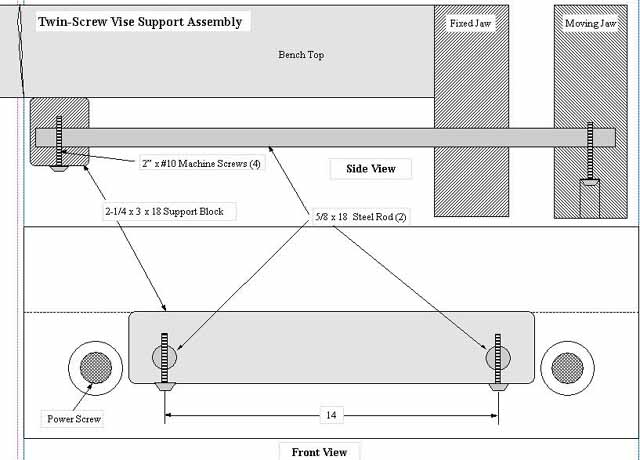


This site is maintained by:
Good-Lyddon Data Systems
Copyright © 2004-2005 Joe Lyddon, WoodWorkStuff.net
|
My workbench is equipped with a Veritas twin-screw vise on the end of the top. My top has a 16" overhang, to accommodate the vise. Before I bought the vise, the only significant criticism I ever read about the Veritas was that the moving jaw of the vise tended to drop nearly 3/8" at full extension in actual use. These may be one reason why Veritas recommends a slanted (tapered) front on the moving jaw. So, I designed a support carriage that practically eliminates that flaw and provides other useful benefits. I made my support using two 18", 5/8" dia. steel guide rods that are fastened securely to the end jaw at one end and to a solid block on the other end. Then I used #10 machine screws to pin the ends. The guide rods pass through the fixed jaw on the bench that serves as a bearing. As the vise is opened, the solid block slides underneath the bench and supports the jaw of the vise. I made my support block by gluing up flat three, 3/4 x 2-3/4 x 18 hardwood pieces. I positioned the holes 16" apart, just to the inside of the power screws. I also made sure that the 5/8" holes in the fixed jaw and the moving jaw were set so that the tops of the guide rods were just above (about 1/8") the tops of the power screws. That way, any stock clamped in the vise would rest on the guide rods rather than the power screws. This has been very useful because it is much easier to clean the guide rods with an abrasive than it is to clean the power screws. The smooth rods also do not scratch the work piece as the jaws move. Power screws would tend to mar soft surfaces when making contact. My vise support holds the end vise vertically so that there is practically no vertical drop even at full extension--even when I put some weight on it. By eliminating this drop, I also have better clamping when using the dogs on the vise together with dogs on the bench. And, I decided it was unnecessary to slant the face of the moving jaw. I notice practically no drag during use, but to help this out, I added a little wax on the top surface of the solid support block and buffed it before installing it. About once a year, I rub on a little more. Best, Edwin |


